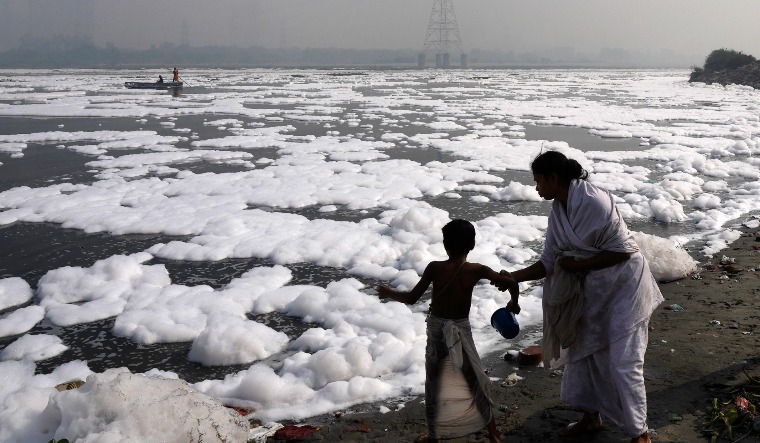Delhi Govt Forms Yamuna Cell To Clean River
Nov 26, 2021 | Pratirodh Bureau
The human chain will extend from Wazirabad to Okhla in Delhi, a 22-kilometer stretch which accounts for 75 per cent of the Yamuna river’s pollution load. Twenty-two drains fall into the river in this stretch. This will probably be the biggest such effort to sensitize the people of Delhi and ensure their participation in cleaning the Yamuna in the capital
Delhi Chief Minister Arvind Kejriwal on Thursday announced the formation of a Yamuna Cleaning Cell (YCC) to expedite inter-departmental decision making and execution of projects for cleaning the heavily polluted Yamuna river.
The Cell, to be headed by the chief executive officer of the Delhi Jal Board (DJB), will have representatives of all the departments concerned, he said.
“In order to expedite inter-departmental decision making and execution, we formed a Yamuna Cleaning Cell (YCC) today, headed by CEO, DJB and representatives of all concerned depts. This will expedite Yamuna cleaning process,” Kejriwal tweeted.
The Cell will guide the Delhi government’s fight against pollution by overcoming administrative hurdles, he said.
“The major hurdle that we were facing in our quest to clean the Yamuna river was the fact that it was plagued by a complex system of being governed by a multiplicity of bodies under the Delhi Government itself,” he added.
Last week, the Delhi Chief Minister announced a six-point action plan to clean the Yamuna, expecting the work will be completed by February 2025.
The action plan includes new sewer treatment plants and raising the capacity of the existing ones, sewer connection of slum clusters and rehabilitation of old sewer systems.
“We are leaving no stone unturned in restoring the lost beauty and sanctity of Yamuna. Formulating Yamuna Cleaning Cell will expedite inter-departmental decision making and execution,” Kejriwal stated as per a statement from the Chief Minister’s Office.
The Chief Minister convened a high-level review meeting on the management of wastewater from industrial areas and slum clusters in respect of Yamuna cleaning, termed the river’s cleaning as top priority of his government and added the river is to be transformed like schools and hospitals were transformed in Delhi, it said.
The Delhi Jal Board will now take over the operations and maintenance of common effluent treatment plants (CETPs) to prevent industrial waste from falling into the Yamuna. Drainage from slum clusters will be diverted to sewage treatment plants to eliminate untreated discharge in storm water drains, the statement said.
Kejriwal instructed the officials to leave no scope for loopholes in the action plan and emphasised that there can be no compromises with the prioritisation of Yamuna cleaning and water supply.
The Cell will oversee the working of all the bodies concerned and help in identifying and delegating responsibility and streamlining projects, he said. The Yamuna Cleaning Cell has been formulated keeping in mind an integrated approach towards Yamuna cleaning, the statement said.
It will consist of six senior officials of the DJB, DUSIB, DSIIDC, DPCC and Irrigation and Flood Control Department looking after sewerage of slum clusters and industrial clusters, CETPs, industries violating pollution norms, Yamuna cleaning projects and in-situ treatment, it said.
These officers will report to the Delhi Jal Board CEO. They will also be responsible for the execution of the decisions taken by the Yamuna Cleaning Cell, it added.
The Cell will further take over the responsibility of sewerage systems of slum clusters, industrial clusters and CETPs. It will also be jointly responsible for all the action points of Yamuna cleaning that include construction of new STPs, upgradation of existing STPs and capacity augmentation, laying of sewerage network in 1799 unauthorised colonies, septage management, desilting of trunk and peripheral sewer lines, providing sewer connections in already notified areas, trapping of 108 drains under ISP and in-situ treatment of drains, the statement said.
Currently, in Delhi, there are about 675 slum clusters which are unsewered. Untreated wastewater generation in JJCs enters river Yamuna, it said. There are 13 CETPs in Delhi that currently cater to 17 industrial areas, it said. (PTI)
